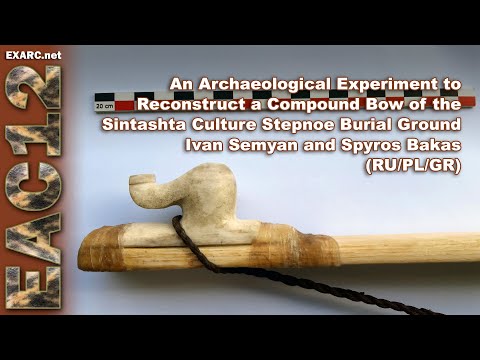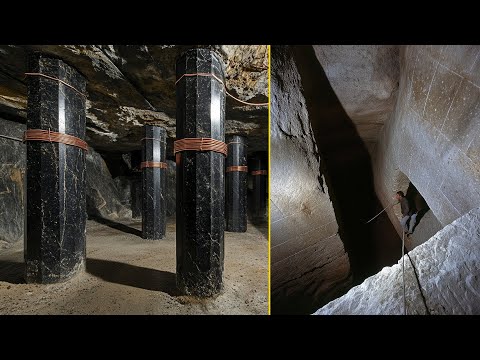An Archaeological Experiment to Reconstruct a Compound Bow

Greetings dear colleagues! We are happy to present our international experimental study on the reconstruction of the “compound” bow of Sintashta culture of bronze age of the South Ural. We are grateful for the opportunity to implement the project to the grant program of the EXARC - “Twinning program”. The Sintashta archaeological culture dates to the XXI to XVIII centuries BC. Distinctive features of the culture are high militarism and the existence of large, fortified settlements, of which 23 are known. The world's oldest chariot complex was found in burials of Sintashta culture, consisting of the weapons of a chariot warrior (bow, axe, spear) and the chariot itself with the necessary cheek pieces elements burials of horses and rich animal sacrifices. Numerous finds of arrowheads and unusual horn details of "compound" bows were found in three Sintashta burial complexes: Kamenny Ambar-5, Stepnoye M, and Solntse II.
These finds illustrate the high importance of the bow among the warriors of this society. The authors of the discovery of the bows and bow parts created graphic reconstructions of a possible design. However, there was no practical reconstruction that could confirm the significance of this technological solution. In January 2019 our team won a research “Twinning program” grant from EXARC and began to develop a completely authentic reconstruction of the Sintashta type bow. The practical experimental experience of reconstructing bows from such an ancient era is unique. This initiative is the first attempt of a scientific reconstruction of the bow associated with the Sintashta culture.
This type of bow appears to be potentially very important, since it provides information about the process of appearance and evolution of complex bows of the steppe breeders, and elucidate the special type of combat based on mobility and long distance in this culture. In the beginning, the study investigated the wide context of finds of bows of the Neolithic-Bronze Age in Eurasia. Archaeological data indicated the development of the self-bow in Mesolithic times. Bronze age cultures of the Steppes, like Yama, Catacomb, Andronovo, Abashevo, and Sintashta, deployed a slow but distinct technological bow-evolution of self-bows, in a parallel perspective with Western, Central, and Eastern Europe. In this context we can see the first archaeological findings of a new type of bow that emerged in the Steppes: the composite bow, which was shorter and more powerful than the regular self-bow. In this perspective, the directive team managed to record the most important relevant archaeological findings (fragments and depictions).
A vast catalog of 47 cases of self, composite, laminate bows or even potential cases of composite bows were recorded, which helped the directive team to understand the technological context of the bow-technology in Eurasia. The vast open landscapes of the Trans-Ural steppe and the endless forest-steppe determined the use of a wide set of long-ranged weapons, mainly represented by the bow and arrow. The high importance of bows is traditionally noted for a number of cultures of the Southern Trans-Urals of the Bronze Age. A complex of horn parts from barrow 4, pit 13 of the Stepnoe burial ground was chosen as the object for reconstruction, since it seems to be the most structurally interesting and integral.
The finds were located in one of the largest pits of the multi-grave mound. Numerous remains of sacrificial animals, including a whole skeleton of a dog, lay on the ceiling of the burial chamber. In ancient times, the pit was robbed. In the burial parallel to it were two disturbed bones of a male and a female. Despite the looting, a rich funeral inventory was preserved in the pit: 4 ornamented vessels, a horn cheekpieces detail with spikes, a wooden object with metal clips, stone tools, 13 arrowheads made of stone, bone, and horn, animal bones, and a piece of silver jewelry.
The horn parts of the bow were located in different parts of the pit, which can be both a consequence of the looting, and a feature of the funeral ritual. Examples of ritual damage to weapons in Sintashta funeral practice are well known. The first item is an object of elaborate shape, it has a rectangular base and a massive S-shaped asymmetrical hook at its reverse side. This hook has a longitudinal grooved channel. The second item is two tips of a bow limb made of elk tines. The third item has a rectangular base with three transversal arranged salient edges, which form two ‘cavities’.
To unify the terminology and the convenience of the scientific description of the processes, we decided to use the following designations for bow details: the “S-hook device” as “Item A”, the elk antler tips as “Item B”, and the “arrow rest” as “Item C”. Based on the archaeological evidence of the contemporary bow technology of the Eurasian basin and noting that the relevant Sintashta burials did not contain any evidence of rectangular or elongated horn/antler remnants , the project team postulated that the bow should be a rare case of a hybrid self-bow that used additional pieces to strengthen its mechanics and functions at the higher possible level for the archer. Furthermore, the calculations of the possible maximum mass of an arrow with a flint tip of ≈ 100 grains, an average length of 27-28’’ (drawing at 26’’), suggest a war-bow of 60+ lbs, of a long type (≈1.8m). Taking into account the rarity of this typology which does not fit in any other of the regular bow-categories which follows the terminology used in the past, the bow can be categorized with caution in the general term of “compound bow”. During the period June-September 2019, our working group in Russia, directed by the skilled master Mr Klim Abramov, produced exact replicas of the antler parts of the bow, based on the relevant burial findings.
Three sets of “Item A”, “B”, and “C” were reconstructed using elk antler (Alces alces) with traditional techniques and tools. For the main procedure of the bow-building, our team cooperated with an experienced bowyer from Greece, Mr Ioannis Boukogiannis who had carried out the construction of the bow-shafts and the assemblage and adjustment of the different parts. Version #1 bow was constructed in late May 2020 and followed the relevant pattern described by Bersenev, Epimakhov and Zdanovich Jr. The reconstructed bow was made of elm wood that had been dried for 10 months.
“Item A” was placed in the outer side of the top end of the bow in the specifically flat shaped surface of the bow-shaft. “Item B” was adjusted in the lower end of the bow ensuring a firm fastening of the bow string. As Bersenev, Epimakhov and Zdanovich have noted, the duality of finds and their location side by side is indirect evidence of this version.
“Item C” was adjusted in the central part of the bow, above the grip, resulting in a peculiar “arrow rest”. The final outcome was a bow of 182 cm in length and a 72-pound draw weight (26’’). The bowyer managed to tiller the bow, and then the bow was put into the first preliminary tests by shooting the experimentally reconstructed arrows in a draw length of 26’’. From mechanics’ perspective, “Items A” and “B” offered an enhanced stiffness and did not allow the smooth bending of the limbs, while the extra mass of “Item A” caused significant imbalance. Soon the experimental shots confirmed our fears, as “Item A” provided significant vibrations and hand shocks, the bow broke above the base of the upper limb. Version 2” bow followed the relevant pattern of Zdanovich Jr. and was constructed in the first half of June 2020.
The reconstructed bow was made of elm wood that had been dried for 10 months. Zdanovich maintains “Item A” in the upper limb but on the inner side of the bow. His innovative proposal is that “Item C” could have a different usage, where its laths were performing more like string notches and that it was placed in the end of the lower limb.
Furthermore, he suggests that the lath served to fasten one end of the string tightly and the S-shape top-end was used to put the bow in a run position with a detached string. All of the items were glued in the bow-shaft with leather glue and wrapped with deer sinew which was dipped in the same glue. The final outcome was a bow of 180 cm in length, and a 65-pound draw weight (26’’). The directive team made an amendment to Zdanovich's version and placed “Item A” in the outer side of the bow.
Otherwise, the bow would not have performed safely: there was critical danger that under significant pressure the item could be detached from the bow shaft and cause severe injury. The tiller was adjusted, and the bow was put to the test. The bow unexpectedly performed comparatively satisfactorily during the experimental shots, as the placement of “Item C” in the bottom end of the bow provided more elasticity and bending efficiency on the lower half of the bow. While drawn, the bow was forming an asymmetrical bending due to the stiffness of the top end of the upper limb (caused by “Item A”).
During the shots, the vibrations were considerably less this time, but still the mass of “Item A” caused the bow to lean forward at the “follow-through” procedure. Version #3 was constructed in June 2020 and was inspired by the relevant work of H. Paulsen. The bow was modified accordingly with input from the directive team. This modified version involved placing “Item A” in the outer side of the upper half of the upper limb, so that we would test the possibility that this device would perform as a peculiar “string-hanger”, where the bow would be hung from the archer's back. The upper tip of the bow was reinforced with a small deer antler tip.
“Item B” was adjusted in the lower end of the bow ensuring a firm fastening of the bow string, while “Item C” was adjusted in the central part of the bow, above the grip, performing as a peculiar “arrow rest”. At this point, we investigated if a device (“Item A”) could be adjusted on the bow and how this would affect the bow mechanics. The final outcome was a bow of 182cm in length, and a 70-pound draw weight (26’’). The experimental shots soon produced obvious difficulties, as “Item A” operated as a "splint" for this small section of the bow and prohibited the proper bending of the limb.
When drawn, the bow was forming an uneven curvature on the upper half and highlighted the fact that this modification worked against the bow-mechanics. During the experimental shots, the vibrations were sufficient enough to destabilize the bow at the “follow-through” procedure and sufficiently interfered with the normal operation of the bow. After the practical functional failure of Version #1 the team proceeded to develop a new theory, which was an upgraded modification of Version #1.
The bow was constructed and tested in August 2020. Due to the fact that “Item A” provided extra mass on the end of the limb causing significant imbalance and vibrations, the bowyer proposed the diametrically opposite placement of “Item A” and “B” and the construction of asymmetrical limbs: This time, “Item A” was now placed in the end of the lower limb while the lower limb was made slightly shorter in length. The latter was done to achieve the maximum possible stiffness and to avoid the possibilities of vibrations. “Item B” was placed in the top end of the upper limb, which had the regular length from the previous versions. The final outcome was a bow of 187 cm in length, and a 64-pound draw weight (26’’).
The results through the experimental shots were comparatively quite satisfactory. When drawn, the asymmetric bow formed a smooth proportional curvature. During the experimental shots, the bow showed remarkable mechanical output, performing under a constant functional repeatability.
“Item A” enhanced the stability of the bow, as it moved the center of mass of the bow to a lower position. The vibrations and hand-shocks, presented in previous versions, were quite limited and the ‘follow-through” movement was more balanced. “Item C” also performed quite well as an arrow-rest.
The choice of the placement of the arrow in the three formed laths of the item, offered three different scaled levels which affected the range of the shot in an absolutely effective way. When the arrow was placed in the lower lath, it was connected with a shot of a close range (<20 m). Putting the arrow in the upper laths connected with targets that were at a long range and required a lifting incline for the arrow. The experimental shots using all the different levels proved the potentially functional use of the item in this way.
The conducted research offered a multi-dimensional approach on the unknown Sintahsta bow technology. The reconstruction perspective of this research centered around the willingness to develop the existing theoretical framework and to submit additional knowledge and practical information. We considered the Items as potential functional equipment pieces of a bow, thus, the next step was to follow the experimental reconstructions and shooting-tests to research the mechanics and performance outputs of the bow under different assembled combinations. As been described before, only Version “4” of the bow provided prospects of functionality. During the experimental tests, Version #4 proved a decent performance and a satisfactory repetitive stability. “Item C” practically performed as a simplified mechanical innovation, as it offered a critical benefit in shooting at targets at scale distances.
It therefore acted as a proportionate modern “shooting diopter” which had to be adjusted according to each shooting distance. On the other hand, “Item A” had a potential dual use. Firstly, it provided an additional small extra weight and mass to the lower limb of the bow, so that the center of mass of the bow would go in a lower height. This is of course was enhanced by the fact that the lower limb was unequal (i.e. shorter) than the upper one and became more stiff resulting in the bow achieving increased stabilization and was balanced in comparison with the previous 3 Versions. Secondly, “Item A” with its inherent special characteristics was always performing as a device for easy attachment and removing of the loop of the string of the bow.
The bow had the firm string fastened in the upper end of the limb and an easily detachable point on the other side, thus helping the warrior to use the bow in a more flexible way during fighting. The dual uses of the ‘’Item A’’, were indirectly associated with the theory of the extensive use of war-chariots by the Sintashta warriors. The Chariot warfare requires constant motion, mobile conflicts and a warrior that can easily adopt different styles of fighting during the battle. It is possible that the warrior would need to easily change weapons in the battlefield, thus a strong war-bow that could be easily braced and unbraced would be a very good selection for his armory.
Furthermore, the fact that the lower limb is unequal/shorter than the upper one, maybe this is an indication of a preliminary realization of one of the basic principles of the war-chariotry: the need of small-sized bows. The bow limbs must be short enough and able to perform in a narrow space, as otherwise they would interfere with the chariot’s box. Placing the bow in the context of material culture and taking into account the current research, it is likely that we have evidence of a very unique case of a bow, which was part of an evolutionary process that took place in Eurasia during the Bronze Age.
The fearsome warriors of the Sintashta culture along with their experimentation in using the chariot for warlike reasons probably also experimented with weapons. The Sintahsta bow could have been a special case of bow type, beyond the framework of the common typology and must be always considered within this context. The Sintashta era created cultural stereotypes of the Steppe population of Northern Eurasia, some of which existed for millennia. There is no doubt that they had a great influence on the type of military affairs at that time, where speed and mobility were important. The horse and the bow were the warrior's main allies.
In the Sintashta era, a warrior on chariot would have struck his enemies with a bow. The authors would like to thank Elena Antoniadou and Maria Semyan for the encouragement they provided throughout the duration of this project. Dear colleagues, thank you very much for the attention!
2021-04-02 14:33


